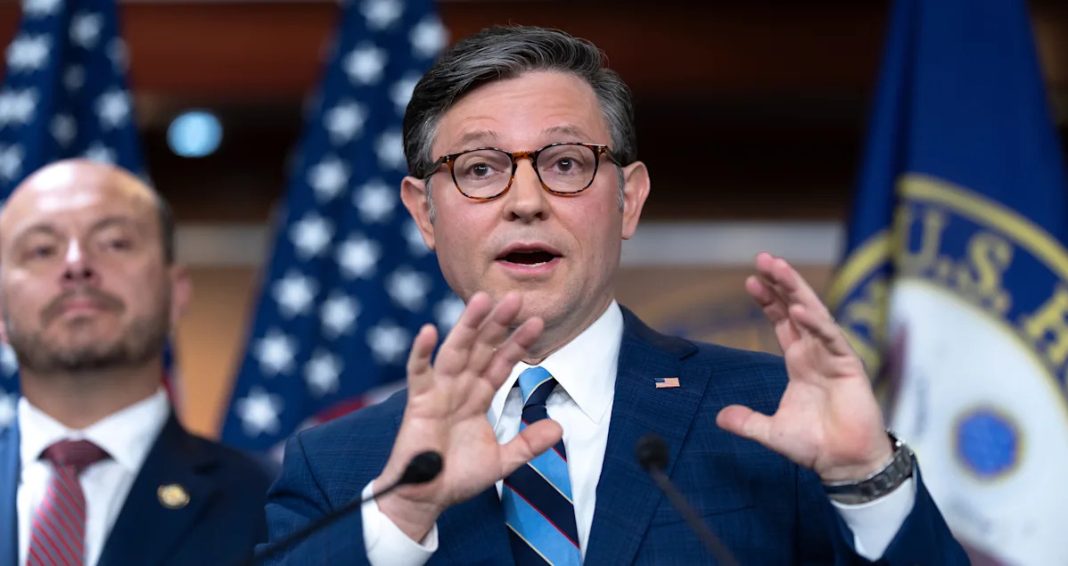The government shutdown has entered day 21 with both parties appearing to be firmly entrenched in the positions that they’ve held since federal funding lapsed on Oct. 1. Late last week, Republican House Speaker Mike Johnson told reporters that he has “no idea” how the impasse may be resolved, a sentiment that pervades Capitol Hill as the shutdown drags on.
“It’s up to the Democrats, and they have to decide it,” Johnson added. “Democrats appear perfectly happy to keep the political theater going while real people suffer.”
It is true that Democrats have not budged at all since the government shut down. They continue to insist that they will only allow a budget to get through the Senate if it includes some of their policy priorities. But Johnson and his fellow Republicans have been equally unyielding.
Johnson has kept the House out of session for more than a month, insisting that there is no reason for the chamber to meet because it already “did its job” by passing a short-term funding bill in mid-September. That bill, which would allow the government to reopen until late next month, was scheduled to be brought up for a vote in the Senate for the 12th time on Wednesday afternoon. That plan was derailed by the 20+-hour speech given on the Senate floor by Oregon Democrat Jeff Merkley. Democrats were expected to block the bill from moving forward, as they have in each of the previous votes.
“Speaker Johnson, what are you afraid of? Democrats are ready to make a deal to lower costs for the American people. Are you?” Democratic Senate Minority Leader Chuck Schumer said in a video recently posted to social media.
On Wednesday, this government shutdown became the second-longest in U.S. history. It is already the longest “full” shutdown, in which the entire federal bureaucracy has run out of funding. The only one that lasted longer, a 34-day standoff during President Trump’s first term, was a “partial” shutdown in which at least some parts of the government were unaffected.
Though there are several areas of disagreement between the parties, the key sticking point that is holding back a deal centers around the Affordable Care Act, commonly known as Obamacare. Subsidies that have made health care plans through Obamacare more affordable for years are set to expire in January, which would cause premiums to spike dramatically. Democrats want those subsidies extended as part of any bill to reopen the government. Republicans say they are willing to discuss the subsidies, but only after the shutdown has ended.
The specific disagreement over Obamacare can only last so long, however. Open enrollment for Affordable Care Act plans begins on Nov. 1, which gives Congress until the end of the month to preserve the subsidies before it will be functionally impossible to implement them. Some state health officials have already said that it may be too late to keep the subsidies intact and that they will have no choice but to offer plans at higher premiums.
If Nov. 1 comes without a deal, that would clear one of the major blocks that has kept the shutdown going, but it remains to be seen whether that would be enough to actually bring the standoff to an end.
Another major factor that could be prolonging the shutdown is Trump. The president has seized on the stalemate as an opportunity to punish his political rivals and to further reshape the federal government. He has canceled billions of dollars in federal funding for projects across the country, mostly concentrated in blue states. He has also fired thousands of government workers and threatened to axe “democratic programs” throughout the government. The legality of each of those moves has been challenged on the grounds that Congress, not the president, has control over government spending. On Oct. 15, a federal judge temporarily blocked Trump from carrying out his plans for mass layoffs.
Democrats have also argued that Trump went outside of his legal authority by reallocating funds to ensure that members of the military continue to get paid during the shutdown and to keep a special food assistance program for low-income mothers and their children from running out of money. While those actions offer relief to millions of Americans, they also alleviate some of the pressure that could have created added urgency for Congress to end the shutdown.
The president’s willingness to defy Congress’s traditional “power of the purse” has also fueled Democrats’ hesitancy to make a deal to reopen the government. Some members of the party have asserted that any bill to reopen the government must include provisions to prevent Trump from overriding congressionally approved budgets whenever he wants.
“He is unchecked at this point,” Rep. Marcy Kaptur told Politico on the day before the shutdown began. “We have to check him. No one should have that kind of power.”

